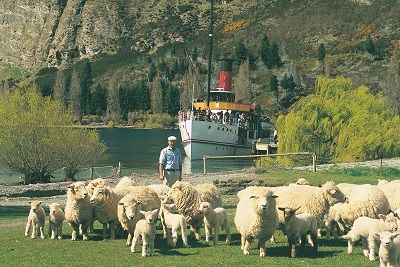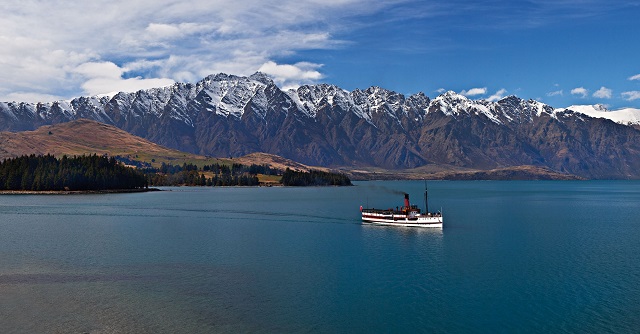Grand Old Lady Leads Change in New Zealand
One of New Zealand’s shipping icons, the coal-fired twin screw steam ship TSS Earnslaw built in 1912, has led the implementation of a new safety management scheme in New Zealand.
As of July 1, 2014, all non-SOLAS vessels in New Zealand are subject to Maritime New Zealand’s (MNZ) new maritime operator safety system (MOSS). In drydock on that day, the Earnslaw has set an example for those that follow in the authority’s goal of improving operator and vessel safety.
.jpg) MOSS replaces the old Safe Ship Management (SSM) system, in which an operator was required to engage a third party to develop a safety system for their vessels. MOSS removes that requirement and places the onus on the operator to develop a safety system covering not only their vessels, but their entire operation.
MOSS replaces the old Safe Ship Management (SSM) system, in which an operator was required to engage a third party to develop a safety system for their vessels. MOSS removes that requirement and places the onus on the operator to develop a safety system covering not only their vessels, but their entire operation.
Around 2000 commercial operators will enter MOSS over the next four years. Over time, MOSS should help to increase safety and reduce the number of boating related injuries and fatalities in both the commercial and tourism sectors, says MNZ director Keith Manch.
The Earnslaw is owned and operated by Real Journeys, the biggest marine tourism operator in New Zealand’s south, and she is one of the few remaining commercial passenger-carrying coal-fired steamship in the southern hemisphere.
“MOSS represents a positive change in that all industry operators will now take direct ownership of their safe operating practices on a day to day basis,” says Richard Lauder, the chief executive of Real Journeys. “We have embraced these new safety changes and are putting a lot of energy into making the transition to the new system as quickly as possible,” he says.
For marine manager, Jon Clow, much of the transition has been relatively simple as Real Journeys was already operating its own internal Safe Ship Company looking after issues such as training and maintenance. Still, new regulations needed to be complied with, and this was followed by a desktop audit and on-site inspections by MNZ. “They came down and went on board our vessels and talked to our mariners to ensure that we were delivering what we stated on paper for our safety systems.
“Qualifications are the biggest challenge for us on the Earnslaw. Our engineers have to be steam qualified and every year that goes by it is becoming more difficult,” he says. There are only a few people in New Zealand with current marine steam experience. However, The New Zealand Maritime School still offers training and certification in steam, and MNZ now recognizes land-based industrial stokers as being able to make the transition to the maritime industry through the MEC5 (Steam) course.
 Real Journeys offers a cruise on Lake Wakatipu aboard the Earnslaw as one of the best ways to experience Queenstown’s famed scenic beauty. Passengers can view the vessel’s engines and boilers from above to watch the stokers at work. “She is very authentic,” says Clow. “The propulsion is still entirely steam driven. There’s been no change to her power system and the original boilers are still used. Nothing is automated and the stokers drive the engines on behalf of the bridge which passes orders by telegraph.” The only addition to the original system from 1912 is some indicator lights that enhance safety during operation.
Real Journeys offers a cruise on Lake Wakatipu aboard the Earnslaw as one of the best ways to experience Queenstown’s famed scenic beauty. Passengers can view the vessel’s engines and boilers from above to watch the stokers at work. “She is very authentic,” says Clow. “The propulsion is still entirely steam driven. There’s been no change to her power system and the original boilers are still used. Nothing is automated and the stokers drive the engines on behalf of the bridge which passes orders by telegraph.” The only addition to the original system from 1912 is some indicator lights that enhance safety during operation.
The vessel travels 1.5 times the circumference of the earth each year. Named after Mount Earnslaw (the highest peak in the region), she is 168 feet in length, 24 feet across the beam and weighs 330 tons.
In the past, she has served the remote farming communities around Lake Wakatipu as cargo ship, livestock carrier, passenger transporter and pleasure steamer. She made a brief cameo appearance in the movie Indiana Jones and the Kingdom of the Crystal Skull (2008) as an Amazon River boat, and parts of her were used as the basis for the SS Venture, the steamship in the movie King Kong.
Queen Elizabeth and Prince Phillip, President Bill Clinton, the King and Queen of Belgium, the Prince of Thailand and the Japanese Emperor and Empress are among the famous people that have enjoyed a cruise onboard the Earnslaw.
Real Journeys’ operations include a wide range of activities such as tourism, workboats, barges and tenders, working in Fiordland, Otago, Foveaux areas – including on lakes, rivers, fiords and open sea. The company has a fleet of 23 vessels and operational bases in Milford Sound, Te Anau, Manapouri, Stewart Island and Queenstown. The company offers a range of excursions including overnight trips on Milford and Doubtful Sounds, and steamship cruises on Queenstown’s Lake Wakatipu.
Vessel details:
Propulsion: Twin coal fired triple expansion, jet condensing vertical marine engines producing 500 horsepower at 145 r.p.m.; cylinder diameters, 13 inches (high pressure), 22 inches (intermediate), 34 inches (low pressure); cylinder stroke, 18 inches
Boilers: Two locomotive-type boilers with double safety valves; grate area, 48 sq. ft.; heating surfaces, 198 sq. ft. (firebox), 1,420 sq. ft. (tubes); working pressure, 180 lb. per sq. in. (reduced to 160 lb. in 1961); steam steering.
Speed (1912): 13 knots normal, 16 knots under forced draught, 19 knots maximum.
Average cruising speed: 12 knots (120 rpm at 160lb psi).
Bunker capacity: Initially 12 tons, later expanded to 14 tons.
Coal consumption at cruising speed: One ton per hour.
Passenger capacity (1912): maximum, 1,035; cargo capacity, 100 tons (or 1,500 sheep, or 200 bales of wool, or 70 head of cattle).
Current passenger survey: 400.

